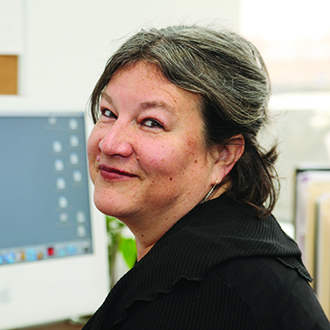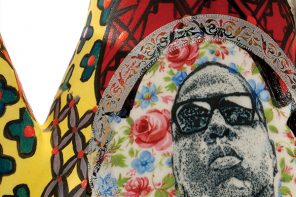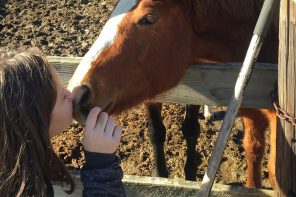Have you been to Wave Hill, the 28-acre public garden and cultural center in the Bronx?
Its mission “is to celebrate the artistry and legacy of its gardens and landscapes, to preserve its magnificent views and to explore human connections to the natural world through programs in horticulture, education and the arts.”
What those words don’t share is how you’ll feel when you first step onto the stunning property in the Riverdale section of the borough.
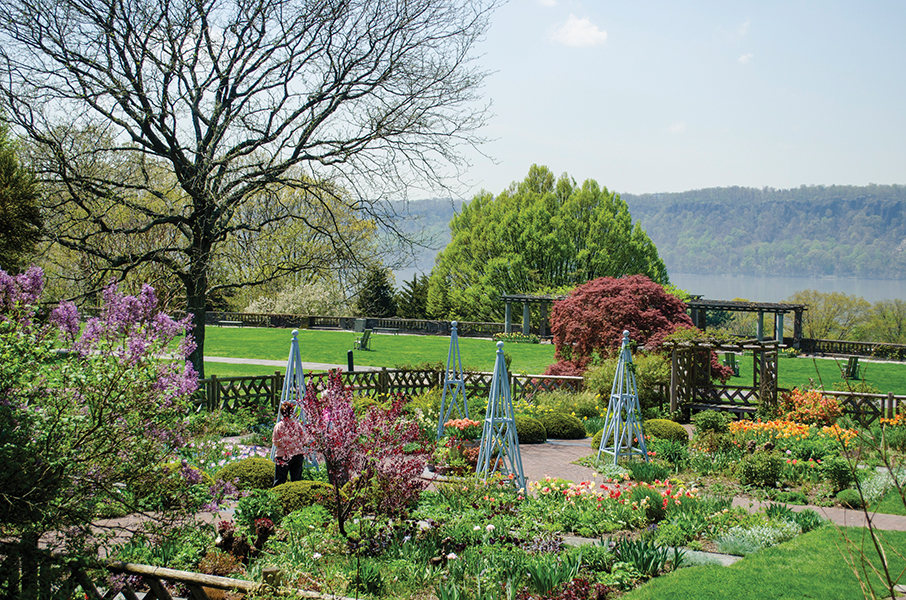
Emerging from the parking lot to pass through a virtual wall of tall trees, you immediately relax as your first glance encompasses the Great Lawn and the majestic Pergola Overlook in the forefront of a dramatic scene anchored by the Hudson River and Palisades just beyond.
A recent morning found WAG savoring it all, as Martha Gellens, Wave Hill’s assistant director of marketing and communications, took us on an informal overview tour of all that Wave Hill offers.
She never tires of that first view, where the parking lot yields to, she says, “this big bowl of blue sky. That’s the sort of ‘fill my lungs’ moment.”
It speaks, as well, to the very heart of Wave Hill, where it’s all about reconnecting with nature, whether that means a walk through a formal garden or simply sitting on a chair and taking in the surroundings, something much needed in today’s world.
“It’s a place of great healing for many people,” Gellens adds. “This is a place where you can pull out the plug.”
But there are certainly, she notes, an abundance of “opportunities for those who want a more curated experience.”
FOR THE BIRDS
Wave Hill, as a flyway for migrating birds, witnesses more than 120 species who make its ecosystem their home. Where birds thrive, the site’s spring brochure notes, people prosper and, in an uncanny coincidence with our issue’s animal-kingdom theme, Wave Hill is “going to the birds” this spring.
With the National Geographic announcement that 2018 is the Year of the Bird, Wave Hill is celebrating the vital role birds play in not only maintaining a healthy ecosystem but also adding pleasure to the landscape.
Programming will include an exhibition, “Avifauna: Interplay of Birds + Habitat,” that opens April 7 in the Glyndor Gallery, which also hosts the popular Winter Workspace program and Sunroom Project Space.
In addition, art workshops, family programming and a “Feathers and Flora Weekend” May 19 and 20 are planned.
No matter the season, Wave Hill’s calendar is full. There are the perhaps expected programs such as garden walks, hands-on gardening workshops and nature offerings. But programming also touches on woodworking, wellness, cooking and food, with numerous lectures, talks and even off-site excursions. On the arts side, there are exhibitions, gallery tours, performing arts events and art workshops. Wave Hill’s noted family programming is led by its signature Family Art Project, while school groups are among the site’s regular visitors.
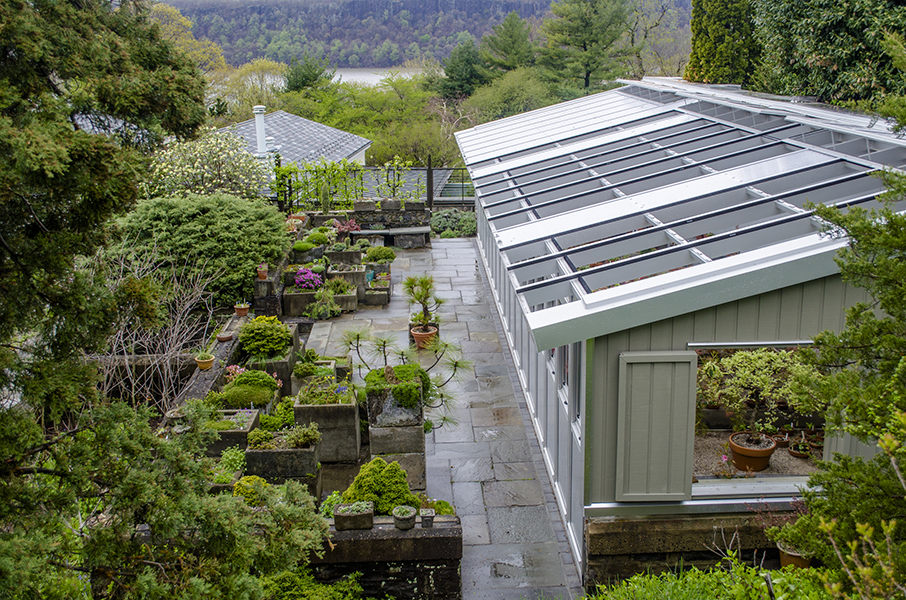
A BRIEF HISTORY
Wave Hill’s roots date from the mid-19th century, when jurist William Lewis Morris built Wave Hill House in 1843 as his country home. It would go on to be owned by publisher William Henry Appleton, who enlarged the house twice in the late 19th century. During that time, Appleton brought pioneering natural scientists such as Thomas Henry Huxley to the site. Over time, the house would have connections with other historical figures. A young Theodore Roosevelt spent summers there in the early 1870s when his family rented the property, while Mark Twain leased the estate from 1901 to ’03, creating a “tree house parlor” in the branches of a chestnut tree on the lawn.
In 1903, financier George W. Perkins, a partner of J.P. Morgan who would be instrumental in the creation of the Palisades Interstate Park Commission, purchased the house as part of an effort to accumulate properties that would create a grand estate along the river. Acquisitions included Oliver Harriman’s adjacent villa on the site of what is now Wave Hill’s Glyndor House. During Perkins’ ownership, he added greenhouses, a swimming pool, terraces and the recreational facility that today is the site’s Ecology Building.
The Perkins family would live in Glyndor House while leasing Wave Hill House to Bashford Dean, a noted zoologist with a hobby of collecting medieval armor. Dean built the Armor Hall to house his collection, part of which was subsequently donated to The Metropolitan Museum of Art.
Other famous residents of Wave Hill House include conductor Arturo Toscanini in the 1940s, as well as chief members of the British Delegation to the United Nations in the 1950s.
In 1960, the Perkins-Freeman family deeded Wave Hill to the city of New York, and Wave Hill Inc. was formed in 1965 as a nonprofit corporation.

A BREADTH OF BEAUTY
A glimpse at the visitor map offers an overview of Wave Hill, dotted with mini-destinations such as the Aquatic Garden, Conifer Slope, Abrons Woodland, Kerlin Overlook, Marco Polo Stufano Conservatory and more.
As Gellens continues our tour, we reach Wave Hill House, a landmark property that now houses The Café at Wave Hill and also hosts the Family Art Project and concerts in Armor Hall. With a lower-level theater, the House is also a popular rental venue for weddings or corporate events and retreats.
The Shop at Wave Hill is found within the Perkins Visitor Center, a bright space complete with a whimsical mural/map created by artist Maira Kalman.
MEMORABLE MOMENTS
During our tour, we learn that the Marco Polo Stufano Conservatory is named after its former director of horticulture (1967-2001), a pivotal figure in the field of gardening.
“Many of our gardeners who work here have a fine-arts background,” Gellens says. “That artistic touch, to me, is what gives the garden its character.”
Wave Hill is full of opportunities for discovery.

The Herb and Dry gardens are terraced gardens that have been created within the stone foundations of former greenhouses.
When it comes to the herbs and those visiting, Gellens says, “We want them to lean down and run their fingers over a mint plant.” Not to take, of course, but to connect with something you might have only seen in a supermarket.
Steps away, the Kerlin Overlook is, she adds, “just a nice place to sit on a warm afternoon and catch the breezes.”
At times, we wander pathways which, she says, are deliberately narrow, “so you have to slow down.”
When Wave Hill kicked off its 50th anniversary festivities in the fall of 2014, it wasn’t only a time to look back but also a time for renewed consideration of its future. Gellens says plans continue to evolve, including those that take advantage of technology, from blogs to social media and beyond.
“We’re looking for more ways to tell the story of what’s happening in the garden,” Gellens says.
And no doubt offer further inspirations for all those who visit, many whom no doubt end up finding a favorite spot or two.
We know we look forward to seeing the Aquatic Garden surrounded by the Upper Pergolas in their full seasonal splendor, while also hoping to take in a sunset concert or wander the grounds during expanded hours on select summer evenings.
A gentle warning: Once you visit the year-round destination that is Wave Hill, you can’t help but dream of coming back again and again.
For more, visit wavehill.org.

